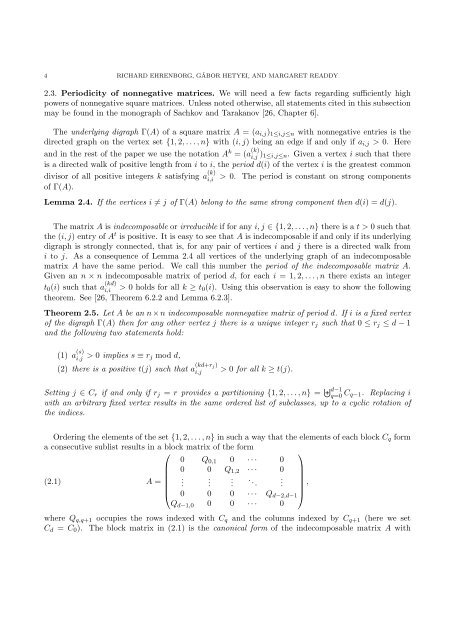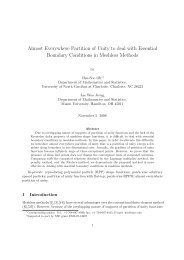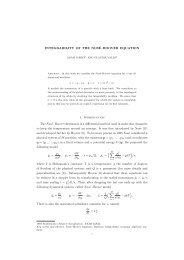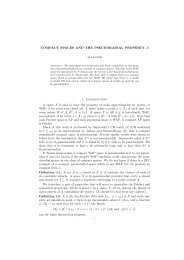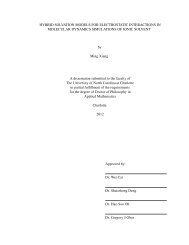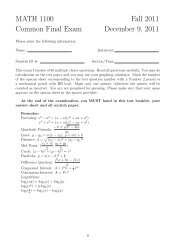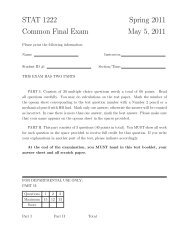LEVEL EULERIAN POSETS 1. Introduction It is the instinct of every ...
LEVEL EULERIAN POSETS 1. Introduction It is the instinct of every ...
LEVEL EULERIAN POSETS 1. Introduction It is the instinct of every ...
Create successful ePaper yourself
Turn your PDF publications into a flip-book with our unique Google optimized e-Paper software.
4 RICHARD EHRENBORG, GÁBOR HETYEI, AND MARGARET READDY<br />
2.3. Periodicity <strong>of</strong> nonnegative matrices. We will need a few facts regarding sufficiently high<br />
powers <strong>of</strong> nonnegative square matrices. Unless noted o<strong>the</strong>rw<strong>is</strong>e, all statements cited in th<strong>is</strong> subsection<br />
may be found in <strong>the</strong> monograph <strong>of</strong> Sachkov and Tarakanov [26, Chapter 6].<br />
The underlying digraph Γ(A) <strong>of</strong> a square matrix A = (ai,j)1≤i,j≤n with nonnegative entries <strong>is</strong> <strong>the</strong><br />
directed graph on <strong>the</strong> vertex set {1, 2, . . . , n} with (i, j) being an edge if and only if ai,j > 0. Here<br />
and in <strong>the</strong> rest <strong>of</strong> <strong>the</strong> paper we use <strong>the</strong> notation A k = (a (k)<br />
i,j )1≤i,j≤n. Given a vertex i such that <strong>the</strong>re<br />
<strong>is</strong> a directed walk <strong>of</strong> positive length from i to i, <strong>the</strong> period d(i) <strong>of</strong> <strong>the</strong> vertex i <strong>is</strong> <strong>the</strong> greatest common<br />
div<strong>is</strong>or <strong>of</strong> all positive integers k sat<strong>is</strong>fying a (k)<br />
i,i<br />
<strong>of</strong> Γ(A).<br />
> 0. The period <strong>is</strong> constant on strong components<br />
Lemma 2.4. If <strong>the</strong> vertices i = j <strong>of</strong> Γ(A) belong to <strong>the</strong> same strong component <strong>the</strong>n d(i) = d(j).<br />
The matrix A <strong>is</strong> indecomposable or irreducible if for any i, j ∈ {1, 2, . . . , n} <strong>the</strong>re <strong>is</strong> a t > 0 such that<br />
<strong>the</strong> (i, j) entry <strong>of</strong> At <strong>is</strong> positive. <strong>It</strong> <strong>is</strong> easy to see that A <strong>is</strong> indecomposable if and only if its underlying<br />
digraph <strong>is</strong> strongly connected, that <strong>is</strong>, for any pair <strong>of</strong> vertices i and j <strong>the</strong>re <strong>is</strong> a directed walk from<br />
i to j. As a consequence <strong>of</strong> Lemma 2.4 all vertices <strong>of</strong> <strong>the</strong> underlying graph <strong>of</strong> an indecomposable<br />
matrix A have <strong>the</strong> same period. We call th<strong>is</strong> number <strong>the</strong> period <strong>of</strong> <strong>the</strong> indecomposable matrix A.<br />
Given an n × n indecomposable matrix <strong>of</strong> period d, for each i = 1, 2, . . . , n <strong>the</strong>re ex<strong>is</strong>ts an integer<br />
t0(i) such that a (kd)<br />
i,i > 0 holds for all k ≥ t0(i). Using th<strong>is</strong> observation <strong>is</strong> easy to show <strong>the</strong> following<br />
<strong>the</strong>orem. See [26, Theorem 6.2.2 and Lemma 6.2.3].<br />
Theorem 2.5. Let A be an n × n indecomposable nonnegative matrix <strong>of</strong> period d. If i <strong>is</strong> a fixed vertex<br />
<strong>of</strong> <strong>the</strong> digraph Γ(A) <strong>the</strong>n for any o<strong>the</strong>r vertex j <strong>the</strong>re <strong>is</strong> a unique integer rj such that 0 ≤ rj ≤ d − 1<br />
and <strong>the</strong> following two statements hold:<br />
(1) a (s)<br />
i,j > 0 implies s ≡ rj mod d,<br />
(2) <strong>the</strong>re <strong>is</strong> a positive t(j) such that a (kd+rj)<br />
i,j > 0 for all k ≥ t(j).<br />
Setting j ∈ Cr if and only if rj = r provides a partitioning {1, 2, . . . , n} = d−1<br />
q=0 Cq−<strong>1.</strong> Replacing i<br />
with an arbitrary fixed vertex results in <strong>the</strong> same ordered l<strong>is</strong>t <strong>of</strong> subclasses, up to a cyclic rotation <strong>of</strong><br />
<strong>the</strong> indices.<br />
Ordering <strong>the</strong> elements <strong>of</strong> <strong>the</strong> set {1, 2, . . . , n} in such a way that <strong>the</strong> elements <strong>of</strong> each block Cq form<br />
a consecutive subl<strong>is</strong>t results in a block matrix <strong>of</strong> <strong>the</strong> form<br />
⎛<br />
0 Q0,1 0 · · ·<br />
⎜ 0 0 Q1,2 · · ·<br />
⎜<br />
(2.1) A = ⎜<br />
.<br />
⎜ . . . ..<br />
⎝ 0 0 0 · · ·<br />
⎞<br />
0<br />
0 ⎟<br />
. ⎟ ,<br />
⎟<br />
Qd−2,d−1⎠<br />
Qd−1,0 0 0 · · · 0<br />
where Qq,q+1 occupies <strong>the</strong> rows indexed with Cq and <strong>the</strong> columns indexed by Cq+1 (here we set<br />
Cd = C0). The block matrix in (2.1) <strong>is</strong> <strong>the</strong> canonical form <strong>of</strong> <strong>the</strong> indecomposable matrix A with


